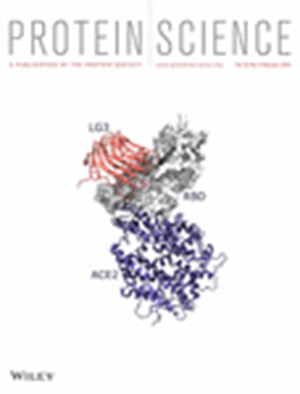影响级联反应总速率因素的分子力学研究:多酶共定位和环境
IF 4.5
3区 生物学
Q1 BIOCHEMISTRY & MOLECULAR BIOLOGY
引用次数: 0
摘要
经过数百万年的进化,许多生物合成途径通过多步催化得以优化。此外,在真核生物的生化过程中,多步代谢途径通常存在于膜结合的细胞器内和细胞器上。促进这些反应过程的基本机制为合成化学中的生物工程代谢途径提供了策略。在这里,我们利用布朗动力学模拟建立了膜上共定位酵母酯生物合成酶的中间底物运输模型。底物乙酸根离子从醛脱氢酶的口袋到达其目标酶乙酰-CoA合成酶,然后底物乙酰CoA从Acs1扩散到下一个酶--醇-O-乙酰转移酶的活性位点。与锚定酶间距离较大的酶相比,排列酶间距离最小(60 Å)的两种酶的平均底物结合时间最快。当开启脱靶副反应时,大多数底物都会丢失,这表明原生定位是高效合成最终产物的必要条件。我们还评估了分子间相互作用、局部底物浓度和膜环境的影响,从而从机理上揭示了共定位途径。计算工作表明,在膜上创建空间组织的多酶可以成为提高生物工程系统最终产物合成的有效策略。本文章由计算机程序翻译,如有差异,请以英文原文为准。
Molecular mechanics studies of factors affecting overall rate in cascade reactions: Multi‐enzyme colocalization and environment
Millions of years of evolution have optimized many biosynthetic pathways by use of multi‐step catalysis. In addition, multi‐step metabolic pathways are commonly found in and on membrane‐bound organelles in eukaryotic biochemistry. The fundamental mechanisms that facilitate these reaction processes provide strategies to bioengineer metabolic pathways in synthetic chemistry. Using Brownian dynamics simulations, here we modeled intermediate substrate transportation of colocalized yeast–ester biosynthesis enzymes on the membrane. The substrate acetate ion traveled from the pocket of aldehyde dehydrogenase to its target enzyme acetyl‐CoA synthetase, then the substrate acetyl CoA diffused from Acs1 to the active site of the next enzyme, alcohol‐O‐acetyltransferase. Arranging two enzymes with the smallest inter‐enzyme distance of 60 Å had the fastest average substrate association time as compared with anchoring enzymes with larger inter‐enzyme distances. When the off‐target side reactions were turned on, most substrates were lost, which suggests that native localization is necessary for efficient final product synthesis. We also evaluated the effects of intermolecular interactions, local substrate concentrations, and membrane environment to bring mechanistic insights into the colocalization pathways. The computation work demonstrates that creating spatially organized multi‐enzymes on membranes can be an effective strategy to increase final product synthesis in bioengineering systems.
求助全文
通过发布文献求助,成功后即可免费获取论文全文。
去求助
来源期刊

Protein Science
生物-生化与分子生物学
CiteScore
12.40
自引率
1.20%
发文量
246
审稿时长
1 months
期刊介绍:
Protein Science, the flagship journal of The Protein Society, is a publication that focuses on advancing fundamental knowledge in the field of protein molecules. The journal welcomes original reports and review articles that contribute to our understanding of protein function, structure, folding, design, and evolution.
Additionally, Protein Science encourages papers that explore the applications of protein science in various areas such as therapeutics, protein-based biomaterials, bionanotechnology, synthetic biology, and bioelectronics.
The journal accepts manuscript submissions in any suitable format for review, with the requirement of converting the manuscript to journal-style format only upon acceptance for publication.
Protein Science is indexed and abstracted in numerous databases, including the Agricultural & Environmental Science Database (ProQuest), Biological Science Database (ProQuest), CAS: Chemical Abstracts Service (ACS), Embase (Elsevier), Health & Medical Collection (ProQuest), Health Research Premium Collection (ProQuest), Materials Science & Engineering Database (ProQuest), MEDLINE/PubMed (NLM), Natural Science Collection (ProQuest), and SciTech Premium Collection (ProQuest).
 求助内容:
求助内容: 应助结果提醒方式:
应助结果提醒方式:


